['Air Programs']
['Air Quality']
06/06/2024
...
§53.30 General provisions.
(a) Determination of comparability. The test procedures prescribed in this subpart shall be used to determine if a candidate method is comparable to a reference method when both methods measure pollutant concentrations in ambient air. Minor deviations in testing requirements and acceptance requirements set forth in this subpart, in connection with any documented extenuating circumstances, may be determined by the Administrator to be acceptable, at the discretion of the Administrator.
(b) Selection of test sites. (1) Each test site shall be in an area which can be shown to have at least moderate concentrations of various pollutants. Each site shall be clearly identified and shall be justified as an appropriate test site with suitable supporting evidence such as a description of the surrounding area, characterization of the sources and pollutants typical in the area, maps, population density data, vehicular traffic data, emission inventories, pollutant measurements from previous years, concurrent pollutant measurements, meteorological data, and other information useful in supporting the suitability of the site for the comparison test or tests.
(2) If approval of one or more proposed test sites is desired prior to conducting the tests, a written request for approval of the test site or sites must be submitted to the address given in §53.4. The request should include information identifying the type of candidate method and one or more specific proposed test sites along with a justification for each proposed specific site as described in paragraph (b)(1) of this section. The EPA will evaluate each proposed site and approve the site, disapprove the site, or request more information about the site. Any such pre-test approval of a test site by the EPA shall indicate only that the site meets the applicable test site requirements for the candidate method type; it shall not indicate, suggest, or imply that test data obtained at the site will necessarily meet any of the applicable data acceptance requirements. The Administrator may exercise discretion in selecting a different site (or sites) for any additional tests the Administrator decides to conduct.
(c) Test atmosphere. Ambient air sampled at an appropriate test site or sites shall be used for these tests. Simultaneous concentration measurements shall be made in each of the concentration ranges specified in tables C-1, C-3, or C-4 of this subpart, as appropriate.
(d) Sampling or sample collection. All test concentration measurements or samples shall be taken in such a way that both the candidate method and the reference method obtain air samples that are alike or as nearly identical as practical.
(e) Operation. Set-up and start-up of the test analyzer(s), test sampler(s), and reference method analyzers or samplers shall be in strict accordance with the applicable operation manual(s).
(f) Calibration. The reference method shall be calibrated according to the appropriate appendix to part 50 of this chapter (if it is a manual method) or according to the applicable operation manual(s) (if it is an automated method). A candidate method (or portion thereof) shall be calibrated according to the applicable operation manual(s), if such calibration is a part of the method.
(g) Submission of test data and other information. All recorder charts, calibration data, records, test results, procedural descriptions and details, and other documentation obtained from (or pertinent to) these tests shall be identified, dated, signed by the analyst performing the test, and submitted. For candidate methods for PM 2.5 and PM 10-2.5, all submitted information must meet the requirements of the ANSI/ASQC E4 Standard, sections 6 (reference 1 of appendix A of this subpart).
§53.31 [Reserved]
§53.32 Test procedures for methods for SO2, CO, O3, and NO2.
(a) Comparability. Comparability is shown for SO2, CO, O3, and NO2 methods when the differences between:
(1) Measurements made by a candidate manual method or by a test analyzer representative of a candidate automated method, and;
(2) Measurements made simultaneously by a reference method are less than or equal to the values for maximum discrepancy specified in table C-1 of this subpart.
(b) Test measurements. All test measurements are to be made at the same test site. If necessary, the concentration of pollutant in the sampled ambient air may be augmented with artificially generated pollutant to facilitate measurements in the specified ranges, as described under paragraph (f)(4) of this section.
(c) Requirements for measurements or samples. All test measurements made or test samples collected by means of a sample manifold as specified in paragraph (f)(4) of this section shall be at a room temperature between 20° and 30°C, and at a line voltage between 105 and 125 volts. All methods shall be calibrated as specified in §53.30(f) prior to initiation of the tests.
(d) Set-up and start-up. (1) Set-up and start-up of the test analyzer, test sampler(s), and reference method shall be in strict accordance with the applicable operation manual(s). If the test analyzer does not have an integral strip chart or digital data recorder, connect the analyzer output to a suitable strip chart or digital data recorder. This recorder shall have a chart width of at least 25 centimeters, a response time of 1 second or less, a deadband of not more than 0.25 percent of full scale, and capability of either reading measurements at least 5 percent below zero or offsetting the zero by at least 5 percent. Digital data shall be recorded at appropriate time intervals such that trend plots similar to a strip chart recording may be constructed with a similar or suitable level of detail.
(2) Other data acquisition components may be used along with the chart recorder during the conduct of these tests. Use of the chart recorder is intended only to facilitate visual evaluation of data submitted.
(3) Allow adequate warmup or stabilization time as indicated in the applicable operation manual(s) before beginning the tests.
(e) Range. (1) Except as provided in paragraph (e)(2) of this section, each method shall be operated in the range specified for the reference method in the appropriate appendix to part 50 of this chapter (for manual reference methods), or specified in table B-1 of Subpart B of this part (for automated reference methods).
(2) For a candidate method having more than one selectable range, one range must be that specified in table B-1 of Subpart B of this part, and a test analyzer representative of the method must pass the tests required by this subpart while operated on that range. The tests may be repeated for one or more broader ranges (i.e., ones extending to higher concentrations) than the one specified in table B-1 of Subpart B of this part, provided that such a range does not extend to concentrations more than four times the upper range limit specified in table B-1 of Subpart B of this part and that the test analyzer has passed the tests required by Subpart B of this part (if applicable) for the broader range. If the tests required by this subpart are conducted or passed only for the range specified in table B-1 of Subpart B of this part, any equivalent method determination with respect to the method will be limited to that range. If the tests are passed for both the specified range and a broader range (or ranges), any such determination will include the broader range(s) as well as the specified range. Appropriate test data shall be submitted for each range sought to be included in such a determination.
(f) Operation of automated methods. (1) Once the test analyzer has been set up and calibrated and tests started, manual adjustment or normal periodic maintenance, as specified in the manual referred to in §53.4(b)(3), is permitted only every 3 days. Automatic adjustments which the test analyzer performs by itself are permitted at any time. The submitted records shall show clearly when manual adjustments were made and describe the operations performed.
(2) All test measurements shall be made with the same test analyzer; use of multiple test analyzers is not permitted. The test analyzer shall be operated continuously during the entire series of test measurements.
(3) If a test analyzer should malfunction during any of these tests, the entire set of measurements shall be repeated, and a detailed explanation of the malfunction, remedial action taken, and whether recalibration was necessary (along with all pertinent records and charts) shall be submitted.
(4) Ambient air shall be sampled from a common intake and distribution manifold designed to deliver homogenous air samples to both methods. Precautions shall be taken in the design and construction of this manifold to minimize the removal of particulate matter and trace gases, and to insure that identical samples reach the two methods. If necessary, the concentration of pollutant in the sampled ambient air may be augmented with artificially generated pollutant. However, at all times the air sample measured by the candidate and reference methods under test shall consist of not less than 80 percent ambient air by volume. Schematic drawings, physical illustrations, descriptions, and complete details of the manifold system and the augmentation system (if used) shall be submitted.
(g) Tests. (1) Conduct the first set of simultaneous measurements with the candidate and reference methods:
(i) Table C-1 of this subpart specifies the type (1-or 24-hour) and number of measurements to be made in each of the three test concentration ranges.
(ii) The pollutant concentration must fall within the specified range as measured by the reference method.
(iii) The measurements shall be made in the sequence specified in table C-2 of this subpart.
(2) For each pair of measurements, determine the difference (discrepancy) between the candidate method measurement and reference method measurement. A discrepancy which exceeds the discrepancy specified in table C-1 of this subpart constitutes a failure. Figure C-1 of this subpart contains a suggested format for reporting the test results.
(3) The results of the first set of measurements shall be interpreted as follows:
(i) Zero failures: The candidate method passes the test for comparability.
(ii) Three or more failures: The candidate method fails the test for comparability.
(iii) One or two failures: Conduct a second set of simultaneous measurements as specified in table C-1 of this subpart. The results of the combined total of first-set and second-set measurements shall be interpreted as follows:
(A) One or two failures: The candidate method passes the test for comparability.
(B) Three or more failures: The candidate method fails the test for comparability.
(iv) For SO2, the 1-hour and 24-hour measurements shall be interpreted separately, and the candidate method must pass the tests for both 1- and 24-hour measurements to pass the test for comparability.
(4) A 1-hour measurement consists of the integral of the instantaneous concentration over a 60-minute continuous period divided by the time period. Integration of the instantaneous concentration may be performed by any appropriate means such as chemical, electronic, mechanical, visual judgment, or by calculating the mean of not less than 12 equally-spaced instantaneous readings. Appropriate allowances or corrections shall be made in cases where significant errors could occur due to characteristic lag time or rise/fall time differences between the candidate and reference methods. Details of the means of integration and any corrections shall be submitted.
(5) A 24-hour measurement consists of the integral of the instantaneous concentration over a 24-hour continuous period divided by the time period. This integration may be performed by any appropriate means such as chemical, electronic, mechanical, or by calculating the mean of twenty-four (24) sequential 1-hour measurements.
(6) For O3 and CO, no more than six 1-hour measurements shall be made per day. For SO2, no more than four 1-hour measurements or one 24-hour measurement shall be made per day. One-hour measurements may be made concurrently with 24-hour measurements if appropriate.
(7) For applicable methods, control or calibration checks may be performed once per day without adjusting the test analyzer or method. These checks may be used as a basis for a linear interpolation-type correction to be applied to the measurements to correct for drift. If such a correction is used, it shall be applied to all measurements made with the method, and the correction procedure shall become a part of the method.
[62 FR 38784, July 18, 1997, as amended at 75 FR 35601, June 22, 2010; 80 FR 65466, Oct. 26, 2015]
§53.33 Test Procedure for Methods for Lead (Pb).
(a) General. The reference method for Pb in TSP includes two parts, the reference method for high-volume sampling of TSP as specified in 40 CFR 50, appendix B and the analysis method for Pb in TSP as specified in 40 CFR 50, appendix G. Correspondingly, the reference method for Pb in PM 10 includes the reference method for low-volume sampling of PM 10 in 40 CFR 50, appendix O and the analysis method of Pb in PM 10 as specified in 40 CFR 50, appendix Q. This section explains the procedures for demonstrating the equivalence of either a candidate method for Pb in TSP to the high-volume reference methods, or a candidate method for Pb in PM 10 to the low-volume reference methods.
(1) Pb in TSP - A candidate method for Pb in TSP specifies reporting of Pb concentrations in terms of standard temperature and pressure. Comparisons of candidate methods to the reference method in 40 CFR 50, appendix G must be made in a consistent manner with regard to temperature and pressure.
(2) Pb in PM 10 - A candidate method for Pb in PM 10 must specify reporting of Pb concentrations in terms of local conditions of temperature and pressure, which will be compared to similarly reported concentrations from the reference method in 40 CFR 50 appendix Q.
(b) Comparability. Comparability is shown for Pb methods when the differences between:
(1) Measurements made by a candidate method, and
(2) Measurements made by the reference method on simultaneously collected Pb samples (or the same sample, if applicable), are less than or equal to the values specified in table C-3 of this subpart.
(c) Test measurements. Test measurements may be made at any number of test sites. Augmentation of pollutant concentrations is not permitted, hence an appropriate test site or sites must be selected to provide Pb concentrations in the specified range.
(d) Collocated samplers. The ambient air intake points of all the candidate and reference method collocated samplers shall be positioned at the same height above the ground level, and between 2 meters (1 meter for samplers with flow rates less than 200 liters per minute (L/min)) and 4 meters apart. The samplers shall be oriented in a manner that will minimize spatial and wind directional effects on sample collection.
(e) Sample collection. Collect simultaneous 24-hour samples of Pb at the test site or sites with both the reference and candidate methods until at least 10 sample pairs have been obtained.
(1) A candidate method for Pb in TSP which employs a sampler and sample collection procedure that are identical to the sampler and sample collection procedure specified in the reference method in 40 CFR part 50, Appendix B, but uses a different analytical procedure than specified in 40 CFR Appendix G, may be tested by analyzing pairs of filter strips taken from a single TSP reference sampler operated according to the procedures specified by that reference method.
(2) A candidate method for Pb in PM 10 which employs a sampler and sample collection procedure that are identical to the sampler and sample collection procedure specified in the reference method in 40 CFR part 50, Appendix O, but uses a different analytical procedure than specified in 40 CFR Appendix Q, requires the use of two PM 10 reference samplers because a single 46.2-mm filter from a reference sampler may not be divided prior to analysis. It is possible to analyze a 46.2-mm filter first with the non-destructive X-ray Fluorescence (XRF) FRM and subsequently extract the filter for other analytical techniques. If the filter is subject to XRF with subsequent extraction for other analyses, then a single PM 10 reference sampler may be used for sample collection.
(3) A candidate method for Pb in TSP or Pb in PM 10 which employs a direct reading (e.g., continuous or semi-continuous sampling) method that uses the same sampling inlet and flow rate as the FRM and the same or different analytical procedure may be tested. The direct measurements are then aggregated to 24-hour equivalent concentrations for comparison with the FRM. For determining precision in section (k), two collocated direct reading devices must be used.
(f) Audit samples. Three audit samples must be obtained from the address given in §53.4(a). For Pb in TSP collected by the high-volume sampling method, the audit samples are 3/4 × 8-inch glass fiber strips containing known amounts of Pb in micrograms per strip (µg/strip) equivalent to the following nominal percentages of the National Ambient Air Quality Standard (NAAQS): 30%, 100%, and 250%. For Pb in PM 10 collected by the low-volume sampling method, the audit samples are 46.2-mm polytetrafluorethylene (PTFE) filters containing known amounts of Pb in micrograms per filter (µg/filter) equivalent to the same percentages of the NAAQS: 30%, 100%, and 250%. The true amount of Pb (Tqi), in total µg/strip (for TSP) or total µg/filter (for PM 10), will be provided for each audit sample.
(g) Filter analysis. (1) For both the reference method samples (e) and the audit samples (f), analyze each filter or filter extract three times in accordance with the reference method analytical procedure. This applies to both the Pb in TSP and Pb in PM 10 methods. The analysis of replicates should not be performed sequentially, i.e., a single sample should not be analyzed three times in sequence. Calculate the indicated Pb concentrations for the reference method samples in micrograms per cubic meter (µg/m 3) for each analysis of each filter. Calculate the indicated total Pb amount for the audit samples in µg/strip for each analysis of each strip or µg/filter for each analysis of each audit filter. Label these test results as R1A, R1B, R1C, R2A, R2B, etc., Q1A, Q1B, Q1C, etc., where R denotes results from the reference method samples; Q denotes results from the audit samples; 1, 2, 3 indicate the filter number, and A, B, C indicate the first, second, and third analysis of each filter, respectively.
(2) For the candidate method samples, analyze each sample filter or filter extract three times and calculate, in accordance with the candidate method, the indicated Pb concentration in µg/m 3 for each analysis of each filter. The analysis of replicates should not be performed sequentially. Label these test results as C1A, C1B, C2C, etc., where C denotes results from the candidate method. For candidate methods which provide a direct reading or measurement of Pb concentrations without a separable procedure, C1A = C1B = C1C, C2A = C2B = C2C, etc.
(h) Average Pb concentration. For the reference method, calculate the average Pb concentration for each filter by averaging the concentrations calculated from the three analyses as described in (g)(1) using equation 1 of this section:

Where, i is the filter number.
(i) Analytical Bias. (1) For the audit samples, calculate the average Pb concentration for each strip or filter analyzed by the reference method by averaging the concentrations calculated from the three analyses as described in (g)(1) using equation 2 of this section:

Where, i is audit sample number.
(2) Calculate the percent difference (Dq) between the average Pb concentration for each audit sample and the true Pb concentration (Tq) using equation 3 of this section:

(3) If any difference value (Dqi) exceeds ±5 percent, the bias of the reference method analytical procedure is out-of-control. Corrective action must be taken to determine the source of the error(s) (e.g., calibration standard discrepancies, extraction problems, etc.) and the reference method and audit sample determinations must be repeated according to paragraph (g) of this section, or the entire test procedure (starting with paragraph (e) of this section) must be repeated.
(j) Acceptable filter pairs. Disregard all filter pairs for which the Pb concentration, as determined in paragraph (h) of this section by the average of the three reference method determinations, falls outside the range of 30% to 250% of the Pb NAAQS level in µg/m 3 for Pb in both TSP and PM 10. All remaining filter pairs must be subjected to the tests for precision and comparability in paragraphs (k) and (l) of this section. At least five filter pairs must be within the specified concentration range for the tests to be valid.
(k) Test for precision. (1) Calculate the precision (P) of the analysis (in percent) for each filter and for each method, as the maximum minus the minimum divided by the average of the three concentration values, using equation 4 or equation 5 of this section:

Where, i indicates the filter number.
(2) If a direct reading candidate method is tested, the precision is determined from collocated devices using equation 5 above.
(3) If any reference method precision value (PRi) exceeds 15 percent, the precision of the reference method analytical procedure is out-of-control. Corrective action must be taken to determine the source(s) of imprecision, and the reference method determinations must be repeated according to paragraph (g) of this section, or the entire test procedure (starting with paragraph (e) of this section) must be repeated.
(4) If any candidate method precision value (PCi) exceeds 15 percent, the candidate method fails the precision test.
(5) The candidate method passes this test if all precision values (i.e., all PRi's and all PCi's) are less than 15 percent.
(l) Test for comparability. (1) For each filter or analytical sample pair, calculate all nine possible percent differences (D) between the reference and candidate methods, using all nine possible combinations of the three determinations (A, B, and C) for each method using equation 6 of this section:

Where, i is the filter number, and n numbers from 1 to 9 for the nine possible difference combinations for the three determinations for each method (j = A, B, C, candidate; k = A, B, C, reference).
(2) If none of the percent differences (D) exceeds ±20 percent, the candidate method passes the test for comparability.
(3) If one or more of the percent differences (D) exceed ±20 percent, the candidate method fails the test for comparability.
(4) The candidate method must pass both the precision test (paragraph (k) of this section) and the comparability test (paragraph (l) of this section) to qualify for designation as an equivalent method.
(m) Method Detection Limit (MDL). Calculate the estimated MDL using the guidance provided in 40 CFR, Part 136 Appendix B. It is essential that all sample processing steps of the analytical method be included in the determination of the method detection limit. Take a minimum of seven blank filters from each lot to be used and calculate the detection limit by processing each through the entire candidate analytical method. Make all computations according to the defined method with the final results in µg/m 3. The MDL of the candidate method must be equal to, or less than 5% of the level of the Pb NAAQS.
[73 FR 67057, Nov. 12, 2008]
§53.34 Test procedure for methods for PM 10 and Class I methods for PM 2.5.
(a) Comparability. Comparability is shown for PM 10 methods and for Class I methods for PM 2.5 when the relationship between:
(1) Measurements made by a candidate method, and
(2) Measurements made by a corresponding reference method on simultaneously collected samples (or the same sample, if applicable) at each of one or more test sites (as required) is such that the linear regression parameters (slope, intercept, and correlation coefficient) describing the relationship meet the requirements specified in table C-4 of this subpart.
(b) Methods for PM10. Test measurements must be made, or derived from particulate samples collected, at not less than two test sites, each of which must be located in a geographical area characterized by ambient particulate matter that is significantly different in nature and composition from that at the other test site(s). Augmentation of pollutant concentrations is not permitted, hence appropriate test sites must be selected to provide the minimum number of test PM 10 concentrations in the ranges specified in table C-4 of this subpart. The tests at the two sites may be conducted in different calendar seasons, if appropriate, to provide PM 10 concentrations in the specified ranges.
(c) PM10methods employing the same sampling procedure as the reference method but a different analytical method. Candidate methods for PM 10 which employ a sampler and sample collection procedure that are identical to the sampler and sample collection procedure specified in the reference method, but use a different analytical procedure, may be tested by analyzing common samples. The common samples shall be collected according to the sample collection procedure specified by the reference method and shall be analyzed in accordance with the analytical procedures of both the candidate method and the reference method.
(d) Methods for PM2.5. Augmentation of pollutant concentrations is not permitted, hence appropriate test sites must be selected to provide the minimum number of test measurement sets to meet the requirements for PM 2.5 concentrations in the ranges specified in table C-4 of this subpart. Only one test site is required, and the site need only meet the PM 2.5 ambient concentration levels required by table C-4 of this subpart and the requirements of §53.30(b) of this subpart. A total of 10 valid measurement sets is required.
(e) Collocated measurements. (1) Set up three reference method samplers collocated with three candidate method samplers or analyzers at each of the number of test sites specified in table C-4 of this subpart.
(2) The ambient air intake points of all the candidate and reference method collocated samplers or analyzers shall be positioned at the same height above the ground level, and between 2 meters (1 meter for samplers or analyzers with flow rates less than 200 L/min) and 4 meters apart. The samplers shall be oriented in a manner that will minimize spatial and wind directional effects on sample collection.
(3) At each site, obtain as many sets of simultaneous PM 10 or PM 2.5 measurements as necessary (see table C-4 of this subpart), each set consisting of three reference method and three candidate method measurements, all obtained simultaneously.
(4) Candidate PM 10 method measurements shall be nominal 24-hour (±1 hour) integrated measurements or shall be averaged to obtain the mean concentration for a nominal 24-hour period. PM 2.5 measurements may be either nominal 24-or 48-hour integrated measurements. All collocated measurements in a measurement set must cover the same nominal 24-or 48-hour time period.
(5) For samplers, retrieve the samples promptly after sample collection and analyze each sample according to the reference method or candidate method, as appropriate, and determine the PM 10 or PM 2.5 concentration in µg/m 3. If the conditions of paragraph (c) of this section apply, collect sample sets only with the three reference method samplers. Guidance for quality assurance procedures for PM 2.5 methods is found in “Quality Assurance Document 2.12” (reference (2) in appendix A to this subpart ).
(f) Sequential samplers. For sequential samplers, the sampler shall be configured for the maximum number of sequential samples and shall be set for automatic collection of all samples sequentially such that the test samples are collected equally, to the extent possible, among all available sequential channels or utilizing the full available sequential capability.
(g) Calculation of reference method averages and precisions. (1) For each of the measurement sets, calculate the average PM 10 or PM 2.5 concentration obtained with the reference method samplers, using equation 7 of this section:
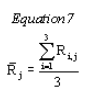
Where:
R = The concentration measurements from the reference methods;
i = The sampler number; and
j = The measurement set number.
(2) For each of the measurement sets, calculate the precision of the reference method PM 10 or PM 2.5 measurements as the standard deviation, PRj, using equation 8 of this section:
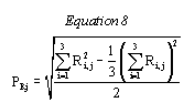
(3) For each measurement set, also calculate the precision of the reference method PM 10 or PM 2.5 measurements as the relative standard deviation, RPRj, in percent, using equation 9 of this section:

(h) Acceptability of measurement sets. Each measurement set is acceptable and valid only if the three reference method measurements and the three candidate method measurements are obtained and are valid, R͞ j falls within the acceptable concentration range specified in table C-4 of this subpart, and either PRj or RPRj is within the corresponding limit for reference method precision specified in table C-4 of this subpart. For each site, table C-4 of this subpart specifies the minimum number of measurement sets required having R͞ j above and below specified concentrations for 24- or 48-hour samples. Additional measurement sets shall be obtained, as necessary, to provide the minimum number of acceptable measurement sets for each category and the minimum total number of acceptable measurement sets for each test site. If more than the minimum number of measurement sets are collected that meet the acceptability criteria, all such measurement sets shall be used to demonstrate comparability.
(i) Candidate method average concentration measurement. For each of the acceptable measurement sets, calculate the average PM 10 or PM 2.5 concentration measurements obtained with the candidate method samplers, using equation 10 of this section:
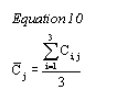
Where:
C = The concentration measurements from the candidate methods;
i = The measurement number in the set; and
j = The measurement set number.
(j) Test for comparability. (1) For each site, plot all of the average PM 10 or PM 2.5 measurements obtained with the candidate method (C͞ j) against the corresponding average PM 10 or PM 2.5 measurements obtained with the reference method (R͞ j. For each site, calculate and record the linear regression slope and intercept, and the correlation coefficient.
(2) To pass the test for comparability, the slope, intercept, and correlation coefficient calculated under paragraph (j)(1) of this section must be within the limits specified in table C-4 of this subpart for all test sites.
§53.35 Test procedure for Class II and Class III methods for PM 2.5 and PM −2.5.
(a) Overview. Class II and Class III candidate equivalent methods shall be tested for comparability of PM 2.5 or PM 10-2.5 measurements to corresponding collocated PM 2.5 or PM 10-2.5 reference method measurements at each of multiple field sites, as required. Comparability is shown for the candidate method when simultaneous collocated measurements made by candidate and reference methods meet the comparability requirements specified in this section §53.35 and in table C-4 of this subpart at each of the required test sites.
(b) Test sites and seasons. A summary of the test site and seasonal testing requirements is presented in table C-5 of this subpart.
(1) Test sites. Comparability testing is required at each of the applicable U.S. test sites required by this paragraph (b). Each test site must also meet the general test site requirements specified in §53.30(b).
(i) PM2.5Class II and Class III candidate methods. Test sites should be chosen to provide representative chemical and meteorological characteristics with respect to nitrates, sulfates, organic compounds, and various levels of temperature, humidity, wind, and elevation. For Class III methods, one test site shall be selected in each of the following four general locations (A, B, C, and D). For Class II methods, two test sites, one western site (A or B) and one midwestern or eastern site (C or D), shall be selected from these locations.
(A) Test site A shall be in the Los Angeles basin or California Central Valley area in a location that is characterized by relatively high PM 2.5, nitrates, and semi-volatile organic pollutants.
(B) Test site B shall be in a western city such as Denver, Salt Lake City, or Albuquerque in an area characterized by cold weather, higher elevation, winds, and dust.
(C) Test site C shall be in a midwestern city characterized by substantial temperature variation, high nitrates, and wintertime conditions.
(D) Test site D shall be in a northeastern or mid-Atlantic city that is seasonally characterized by high sulfate concentrations and high relative humidity.
(ii) PM10-2.5Class II and Class III candidate methods. Test sites shall be chosen to provide modest to high levels of PM 10-2.5 representative of locations in proximity to urban sources of PM 10-2.5 such as high-density traffic on paved roads, industrial sources, and construction activities. For Class III methods, one test site shall be selected in each of the four following general locations (A, B, C, and D), and at least one of the test sites shall have characteristic wintertime temperatures of 0°C or lower. For Class II methods, two test sites, one western site (A or B) and one midwestern or eastern site (C or D), shall be selected from these locations.
(A) Test site A shall be in the Los Angeles basin or the California Central Valley area in a location that is characterized by relatively high PM 2.5, nitrates, and semi-volatile organic pollutants.
(B) Test site B shall be in a western city characterized by a high ratio of PM 10-2.5 to PM 2.5, with exposure to windblown dust, such as Las Vegas or Phoenix.
(C) Test site C shall be in a midwestern city characterized by substantial temperature variation, high nitrates, and wintertime conditions.
(D) Site D shall be in a large city east of the Mississippi River, having characteristically high humidity levels.
(2) Test seasons. (i) For PM 2.5 and PM 10-2.5 Class III candidate methods, test campaigns are required in both summer and winter seasons at test site A, in the winter season only at test sites B and C, and in the summer season only at test site D. (A total of five test campaigns is required.) The summer season shall be defined as the typically warmest three or four months of the year at the site; the winter season shall be defined as the typically coolest three or four months of the year at the site.
(ii) For Class II PM 2.5 and PM 10-2.5 candidate methods, one test campaign is required at test site A or B and a second test campaign at test site C or D (total of two test campaigns).
(3) Test concentrations. The test sites should be selected to provide ambient concentrations within the concentration limits specified in table C-4 of this subpart, and also to provide a wide range of test concentrations. A narrow range of test concentrations may result in a low concentration coefficient of variation statistic for the test measurements, making the test for correlation coefficient more difficult to pass (see paragraph (h) of this section, test for comparison correlation).
(4) Pre-approval of test sites. The EPA recommends that the applicant seek EPA approval of each proposed test site prior to conducting test measurements at the site. To do so, the applicant should submit a request for approval as described in §53.30(b)(2).
(c) Collocated measurements. (1) For each test campaign, three reference method samplers and three candidate method samplers or analyzers shall be installed and operated concurrently at each test site within each required season (if applicable), as specified in paragraph (b) of this section. All reference method samplers shall be of single-filter design (not multi-filter, sequential sample design). Each candidate method shall be setup and operated in accordance with its associated manual referred to in §53.4(b)(3) and in accordance with applicable guidance in “Quality Assurance Document 2.12” (reference (2) in appendix A to this subpart ). All samplers or analyzers shall be placed so that they sample or measure air representative of the surrounding area (within one kilometer) and are not unduly affected by adjacent buildings, air handling equipment, industrial operations, traffic, or other local influences. The ambient air inlet points of all samplers and analyzers shall be positioned at the same height above the ground level and between 2 meters (1 meter for instruments having sample inlet flow rates less than 200 L/min) and 4 meters apart.
(2) A minimum of 23 valid and acceptable measurement sets of PM 2.5 or PM 10-2.5 24-hour (nominal) concurrent concentration measurements shall be obtained during each test campaign at each test site. To be considered acceptable for the test, each measurement set shall consist of at least two valid reference method measurements and at least two valid candidate method measurements, and the PM 2.5 or PM 10-2.5 measured concentration, as determined by the average of the reference method measurements, must fall within the acceptable concentration range specified in table C-4 of this subpart. Each measurement set shall include all valid measurements obtained. For each measurement set containing fewer than three reference method measurements or fewer than three candidate method measurements, an explanation and appropriate justification shall be provided to account for the missing measurement or measurements.
(3) More than 23 valid measurement sets may be obtained during a particular test campaign to provide a more advantageous range of concentrations, more representative conditions, additional higher or lower measurements, or to otherwise improve the comparison of the methods. All valid data sets obtained during each test campaign shall be submitted and shall be included in the analysis of the data.
(4) The integrated-sample reference method measurements shall be of at least 22 hours and not more than 25 hours duration. Each reference method sample shall be retrieved promptly after sample collection and analyzed according to the reference method to determine the PM 2.5 or PM 10-2.5 measured concentration in µg/m 3. Guidance and quality assurance procedures applicable to PM 2.5 or PM 10-2.5 reference methods are found in “Quality Assurance Document 2.12” (reference (2) in appendix A to this subpart ).
(5) Candidate method measurements shall be timed or processed and averaged as appropriate to determine an equivalent mean concentration representative of the same time period as that of the concurrent integrated-sample reference method measurements, such that all measurements in a measurement set shall be representative of the same time period. In addition, hourly average concentration measurements shall be obtained from each of the Class III candidate method analyzers for each valid measurement set and submitted as part of the application records.
(6) In the following tests, all measurement sets obtained at a particular test site, from both seasonal campaigns if applicable, shall be combined and included in the test data analysis for the site. Data obtained at different test sites shall be analyzed separately. All measurements should be reported as normally obtained, and no measurement values should be rounded or truncated prior to data analysis. In particular, no negative measurement value, if otherwise apparently valid, should be modified, adjusted, replaced, or eliminated merely because its value is negative. Calculated mean concentrations or calculated intermediate quantities should retain at least one order-of-magnitude greater resolution than the input values. All measurement data and calculations shall be recorded and submitted in accordance with §53.30(g), including hourly test measurements obtained from Class III candidate methods.
(d) Calculation of mean concentrations - (1) Reference method outlier test. For each of the measurement sets for each test site, check each reference method measurement to see if it might be an anomalous value (outlier) as follows, where Ri,j is the measurement of reference method sampler i on test day j. In the event that one of the reference method measurements is missing or invalid due to a specific, positively-identified physical cause (e.g., sampler malfunction, operator error, accidental damage to the filter, etc.; see paragraph (c)(2) of this section), then substitute zero for the missing measurement, for the purposes of this outlier test only.
(i) Calculate the quantities 2 × R1,j/(R1,j + R2,j) and 2 × R1,j/(R1,j + R3,j). If both quantities fall outside of the interval, (0.93, 1.07), then R1,j is an outlier.
(ii) Calculate the quantities 2 × R2,j/(R2,j + R1,j) and 2 × R2,j/(R2,j + R3,j). If both quantities fall outside of the interval, (0.93, 1.07), then R2,j is an outlier.
(iii) Calculate the quantities 2 × R3,j/(R3,j + R1,j) and 2 × R3,j/(R3,j + R2,j). If both quantities fall outside of the interval, (0.93, 1.07), then R3,j is an outlier.
(iv) If this test indicates that one of the reference method measurements in the measurement set is an outlier, the outlier measurement shall be eliminated from the measurement set, and the other two measurements considered valid. If the test indicates that more than one reference method measurement in the measurement set is an outlier, the entire measurement set (both reference and candidate method measurements) shall be excluded from further data analysis for the tests of this section.
(2) For each of the measurement sets for each test site, calculate the mean concentration for the reference method measurements, using equation 11 of this section:

Where:
R͞ j = The mean concentration measured by the reference method for the measurement set;
Ri,j = The measurement of reference method sampler i on test day j; and
n = The number of valid reference method measurements in the measurement set (normally 3).
(3) Any measurement set for which R͞ j does not fall in the acceptable concentration range specified in table C-4 of this subpart is not valid, and the entire measurement set (both reference and candidate method measurements) must be eliminated from further data analysis.
(4) For each of the valid measurement sets at each test site, calculate the mean concentration for the candidate method measurements, using equation 12 of this section. (The outlier test in paragraph (d)(1) of this section shall not be applied to the candidate method measurements.)
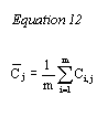
Where:
Cj = The mean concentration measured by the candidate method for the measurement set;
Ci,j = The measurement of the candidate method sampler or analyzer i on test day j; and
m = The number of valid candidate method measurements in the measurement set (normally 3).
(e) Test for reference method precision. (1) For each of the measurement sets for each site, calculate an estimate for the relative precision of the reference method measurements, RPj, using equation 13 of this section:

(2) For each site, calculate an estimate of reference method relative precision for the site, RP, using the root mean square calculation of equation 14 of this section:

Where, J is the total number of valid measurement sets for the site.
(3) Verify that the estimate for reference method relative precision for the site, RP, is not greater than the value specified for reference method precision in table C-4 of this subpart. A reference method relative precision greater than the value specified in table C-4 of this subpart indicates that quality control for the reference method is inadequate, and corrective measures must be implemented before proceeding with the test.
(f) Test for candidate method precision. (1) For each of the measurement sets, for each site, calculate an estimate for the relative precision of the candidate method measurements, CPj, using equation 15 of this section:
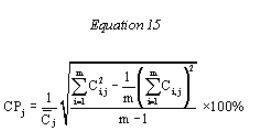
(2) For each site, calculate an estimate of candidate method relative precision for the site, CP, using the root mean square calculation of equation 16 of this section:

Where, J is the total number of valid measurement sets for the site.
(3) To pass the test for precision, the mean candidate method relative precision at each site must not be greater than the value for candidate method precision specified in table C-4 of this subpart.
(g) Test for additive and multiplicative bias (comparative slope and intercept). (1) For each test site, calculate the mean concentration measured by the reference method, R͞, using equation 17 of this section:

(2) For each test site, calculate the mean concentration measured by the candidate method, C͞, using equation 18 of this section:

(3) For each test site, calculate the linear regression slope and intercept of the mean candidate method measurements (C͞ j) against the mean reference method measurements (R͞ j), using equations 19 and 20 of this section, respectively:
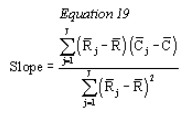

(4) To pass this test, at each test site:
(i) The slope (calculated to at least 2 decimal places) must be in the interval specified for regression slope in table C-4 of this subpart; and
(ii) The intercept (calculated to at least 2 decimal places) must be in the interval specified for regression intercept in table C-4 of this subpart.
(iii) The slope and intercept limits are illustrated in figures C-2 and C-3 of this subpart.
(h) Tests for comparison correlation. (1) For each test site, calculate the (Pearson) correlation coefficient, r (not the coefficient of determination, r 2), using equation 21 of this section:
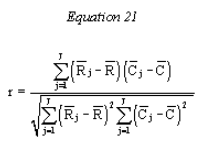
(2) For each test site, calculate the concentration coefficient of variation, CCV, using equation 22 of this section:
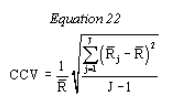
(3) To pass the test, the correlation coefficient, r, for each test site must not be less than the values, for various values of CCV, specified for correlation in table C-4 of this subpart. These limits are illustrated in figure C-4 of this subpart.
[71 FR 61278, Oct. 17, 2006, as amended at 72 FR 32202, June 12, 2007; 89 FR 16386, March 6, 2024]
Table C-1 to Subpart C of Part 53 - Test Concentration Ranges, Number of Measurements Required, and Maximum Discrepancy Specifications
| Pollutant | Concentration range, parts per million (ppm) | Simultaneous measurements required |
Maximum
discrepancy specification, parts per million | |||
| 1-hour | 2-hour | |||||
| First set | Second set | First set | Second set | |||
| Ozone | Low 0.06 to 0.10 | 5 | 6 | 0.02 | ||
| Med. 0.15 to 0.25 | 5 | 6 | 0.03 | |||
| High 0.35 to 0.46 | 4 | 6 | 0.04 | |||
| Total | 14 | 18 | ||||
| Carbon monoxide | Low 7 to 11 | 5 | 6 | 1.5 | ||
| Med. 20 to 30 | 5 | 6 | 2.0 | |||
| High 25 to 45 | 4 | 6 | 3.0 | |||
| Total | 14 | 18 | ||||
| Sulfur dioxide | Low 0.02 to 0.05 | 5 | 6 | 3 | 3 | 0.02 |
| Med. 0.10 to 0.15 | 5 | 6 | 2 | 3 | 0.03 | |
| High 0.30 to 0.50 | 4 | 6 | 2 | 2 | 0.04 | |
| Total | 14 | 18 | 7 | 8 | ||
| Nitrogen dioxide | Low 0.02 to 0.08 | 3 | 3 | 0.02 | ||
| Med. 0.10 to 0.20 | 2 | 2 | 0.02 | |||
| High 0.25 | 2 | 2 | 0.03 | |||
| Total | 7 | 8 | ||||
[75 FR 35601, June 22, 2010]
Table C-2 to Subpart C of Part 53 - Sequence of Test Measurements
| Measurement | Concentration range | |
|---|---|---|
| First set | Second set | |
| 1 | Low | Medium. |
| 2 | High | High. |
| 3 | Medium | Low. |
| 4 | High | High. |
| 5 | Low | Medium. |
| 6 | Medium | Low. |
| 7 | Low | Medium. |
| 8 | Medium | Low. |
| 9 | High | High. |
| 10 | Medium | Low. |
| 11 | High | Medium. |
| 12 | Low | High. |
| 13 | Medium | Medium. |
| 14 | Low | High. |
| 15 | Low. | |
| 16 | Medium. | |
| 17 | Low. | |
| 18 | High. | |
Table C-3 to Subpart C of Part 53 - Test Specifications for Pb in TSP and Pb in PM 10 Methods
| Concentration range equivalent to percentage of NAAQS in µg/m 3 | 30% to 250% |
| Minimum number of 24-hr measurements | 5 |
| Maximum reference method analytical bias, Dq | ±5% |
| Maximum precision, PR or PC | ≤15% |
| Maximum difference (D) | ±20% |
| Estimated Method Detection Limit (MDL), µg/m 3 | 5% of NAAQS level. |
[73 FR 67059, Nov. 12, 2008]
Table C–4 to Subpart C of Part 53—Test Specifications for PM 10 , PM 2.5 , and PM 10–2.5 Candidate Equivalent Methods
| Specification | PM 10 | PM 2.5 | PM 10–2.5 | |||
|---|---|---|---|---|---|---|
| Class I | Class II | Class III | Class II | Class III | ||
| 1 Some missing daily measurement values may be permitted; see test procedure. | ||||||
| 2 Calculated as the root mean square over all measurement sets. | ||||||
| Acceptable concentration range (R j), µg/m 3 | 5–300 | 3–200 | 3–200 | 3–200 | 3–200 | 3–200. |
| Minimum number of test sites | 2 | 1 | 2 | 4 | 2 | 4. |
| Minimum number of candidate method samplers or analyzers per site | 3 | 3 | 3 1 | 3 1 | 3 1 | 3. 1 |
| Number of reference method samplers per site | 3 | 3 | 3 1 | 3 1 | 3 1 | 3. 1 |
| Minimum number of acceptable sample sets per site for PM 10 methods: | ||||||
| R j < 20 µg/m 3 | 3 | |||||
| R j > 20 µg/m 3 | 3 | |||||
| Total | 10 | |||||
| Minimum number of acceptable sample sets per site for PM 2.5 and PM 10–2.5 candidate equivalent methods: | ||||||
| R j < 15 µg/m 3 for 24-hr or R j < 8 µg/m 3 for 48-hr samples. | 3 | 3 | 3 | 3 | 3. | |
| Rj > 15 µg/m 3 for 24-hr or R j > 8 µg/m 3 for 48-hr samples | 3 | 3 | 3 | 3 | 3. | |
| Each season | 10 | 23 | 23 | 23 | 23. | |
| Total, each site | 10 | 23 | 23 (46 for two-season sites) | 23 | 23 (46 for two-season sites). | |
| Precision of replicate reference method measurements, P Rj or RP Rj , respectively; RP for Class II or III PM 2.5 or PM 10–2.5 , maximum | 5 μg/m 3 or 7%. | 2 μg/m 3 or 5%. | 10% 2 | 10% 2 | 10% 2 | 10%. 2 |
| Precision of PM 2.5 or PM 10–2.5 candidate method, CP, each site | 10% 2 | 15% 2 | 15% 2 | 15%. 2 | ||
| Slope of regression relationship | 1 ±0.10 | 1 ±0.05 | 1 ±0.10 | 1 ±0.10 | 1 ±0.10 | 1 ±0.12. |
| Intercept of regression relationship, µg/m 3 | 0 ±5 | 0 ±1 | Between: 13.55—(15.05 × slope), but not less than—1.5; and 16.56—(15.05 × slope), but not more than +1.5 | Between: 15.05—(17.32 × slope), but not less than—2.0; and 15.05—(13.20 × slope), but not more than +2.0 | Between: 62.05—(70.5 × slope), but not less than—3.5; and 78.95—(70.5 × slope), but not more than +3.5 | Between: 70.50—(82.93 × slope), but not less than—7.0; and 70.50—(61.16 × slope), but not more than +7.0. |
| Correlation of reference method and candidate method measurements | ≥ 0.97 | ≥ 0.97 | ≥ 0.93—for CCV ≤ 0.4; ≥ 0.85 + 0.2 × CCV—for 0.4 ≤ CCV ≤ 0.5; ≥ 0.95—for CCV ≥ 0.5 | |||
[72 FR 32203, June 12, 2007; 89 FR 16386, March 6, 2024]
Table C-5 to Subpart C of Part 53 - Summary of Comparability Field Testing Campaign Site and Seasonal Requirements for Class II and III FEMs for PM 10-2.5 and PM 2.5
| Candidate method | Test site | A | B | C | D |
|---|---|---|---|---|---|
| PM 2.5 | Test site location area | Los Angeles basin or California Central Valley | Western city such as Denver, Salt Lake City, or Albuquerque | Midwestern city | Northeastern or mid-Atlantic city. |
| Test site characteristics | Relatively high PM 2.5, nitrates, and semi-volatile organic pollutants | Cold weather, higher elevation, winds, and dust | Substantial temperature variation, high nitrates, wintertime conditions | High sulfate and high relative humidity. | |
| Class III Field test campaigns (Total: 5) | Winter and summer | Winter only | Winter only | Summer only. | |
| Class II Field test campaigns (Total: 2) | Site A or B, any season | Site C or D, any season. | |||
| PM 10-2.5 | Test site location area | Los Angeles basin or California Central Valley | Western city such as Las Vegas or Phoenix | Midwestern city | Large city east of the Mississippi River. |
| Test site characteristics | Relatively high PM 2.5, nitrates, and semi-volatile organic pollutants | High PM 10-2.5 to PM 2.5 ratio, windblown dust | Substantial temperature variation, high nitrates, wintertime conditions | High sulfate and high relative humidity. | |
| Class III Field test campaigns (Total: 5) | Winter and summer | Winter only | Winter only | Summer only. | |
| Class II Field test campaigns (Total: 2) | Site A or B, any season | Site C or D, any season. | |||
Figure C-1 to Subpart C of Part 53 - Suggested Format for Reporting Test Results for Methods for SO 2, CO, O 3, NO 2
Candidate Method
Reference Method
Applicant
□ First Set □ Second Set □ Type □ 1 Hour □ 24 Hour
| Concentration range | Date | Time | Concentration, ppm | Difference | Table C-1 spec. | Pass or fail | ||
|---|---|---|---|---|---|---|---|---|
| Candidate | Reference | |||||||
| Low | 1 | |||||||
| ____ ppm | 2 | |||||||
| to ____ ppm | 3 | |||||||
| 4 | ||||||||
| 5 | ||||||||
| 6 | ||||||||
| Medium | 1 | |||||||
| ____ ppm | 2 | |||||||
| to ____ ppm | 3 | |||||||
| 4 | ||||||||
| 5 | ||||||||
| 6 | ||||||||
| High | 1 | |||||||
| ____ ppm | 2 | |||||||
| to ____ ppm | 3 | |||||||
| 4 | ||||||||
| 5 | ||||||||
| 6 | ||||||||
| 7 | ||||||||
| 8 | ||||||||
| Total Failures: | ||||||||
[72 FR 32204, June 12, 2007]
Figure C-2 to Subpart C of Part 53 - Illustration of the Slope and Intercept Limits for Class II and Class III PM 2.5 Candidate Equivalent Methods
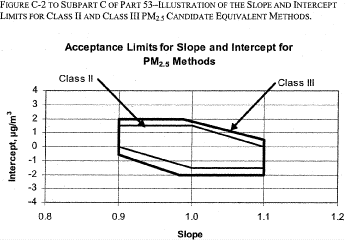
[72 FR 32204, June 12, 2007]
Figure C-3 to Subpart C of Part 53 - Illustration of the Slope and Intercept Limits for Class II and Class III PM 10-2.5 Candidate Equivalent Methods
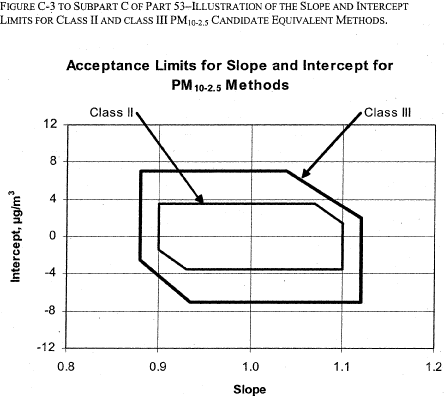
[72 FR 32204, June 12, 2007]
Figure C-4 to Subpart C of Part 53 - Illustration of the Minimum Limits for Correlation Coefficient for PM 2.5 and PM 10-2.5 Class II and III Methods
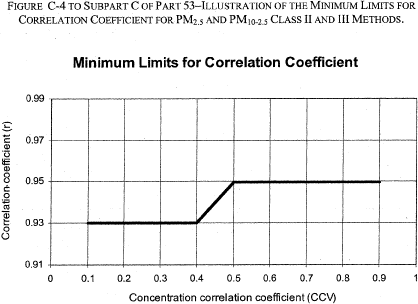
[72 FR 32204, June 12, 2007]
Appendix A to Subpart C of Part 53 - References
(1) American National Standard Quality Systems for Environmental Data and Technology Programs - Requirements with guidance for use, ANSI/ASQC E4-2004. Available from American Society for Quality, P.O. Box 3005, Milwaukee, WI 53202 (http://qualitypress.asq.org).
(2) Quality Assurance Guidance Document 2.12. Monitoring PM 2.5 in Ambient Air Using Designated Reference or Class I Equivalent Methods. U.S. EPA, National Exposure Research Laboratory, Research Triangle Park, NC, November 1998 or later edition. Currently available at http://www.epa.gov/ttn/amtic/pmqainf.html.
['Air Programs']
['Air Quality']
UPGRADE TO CONTINUE READING
Load More
J. J. Keller is the trusted source for DOT / Transportation, OSHA / Workplace Safety, Human Resources, Construction Safety and Hazmat / Hazardous Materials regulation compliance products and services. J. J. Keller helps you increase safety awareness, reduce risk, follow best practices, improve safety training, and stay current with changing regulations.
Copyright 2025 J. J. Keller & Associate, Inc. For re-use options please contact copyright@jjkeller.com or call 800-558-5011.
